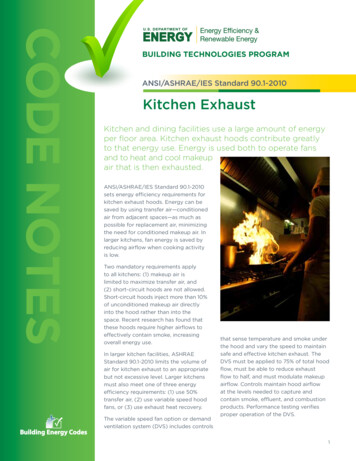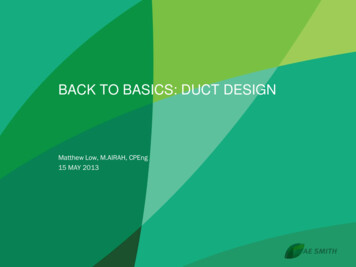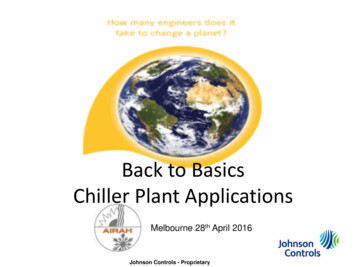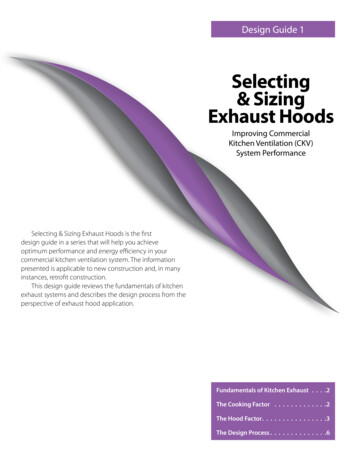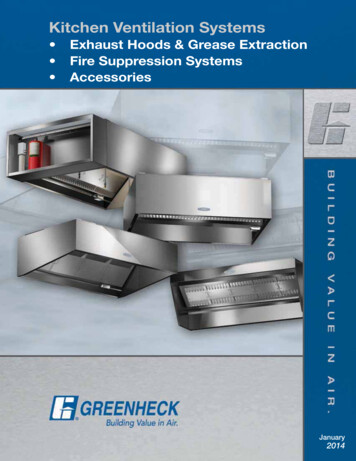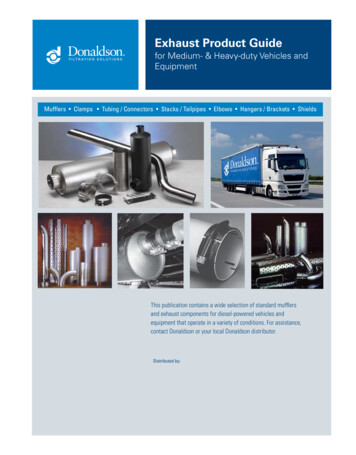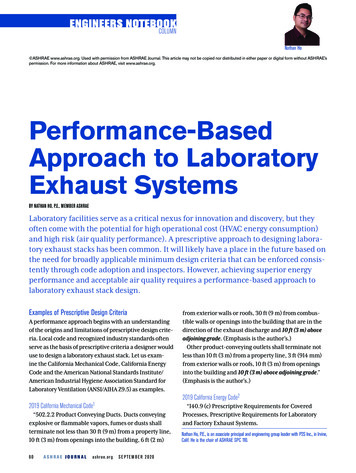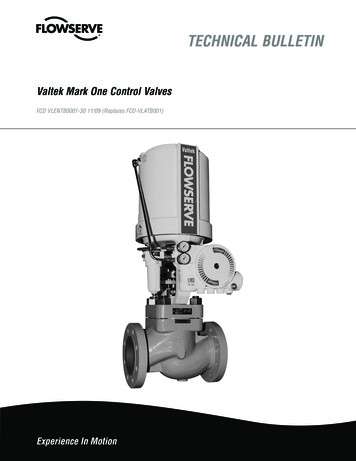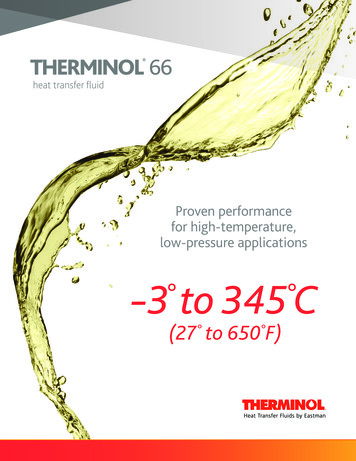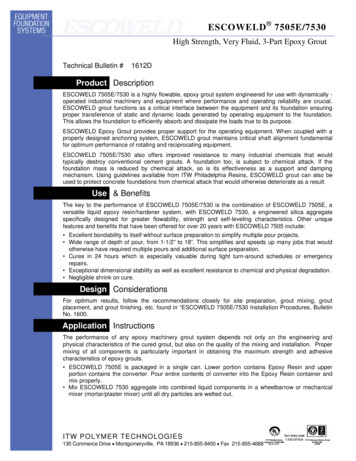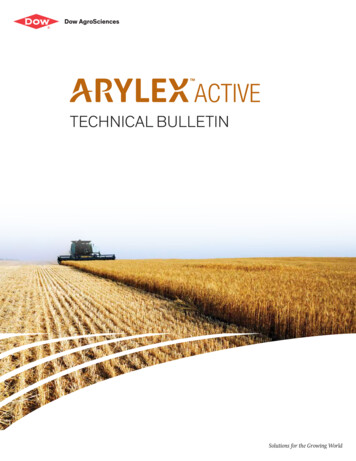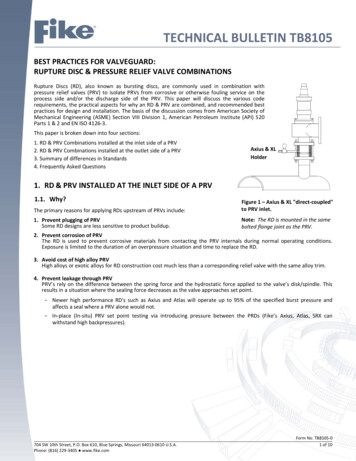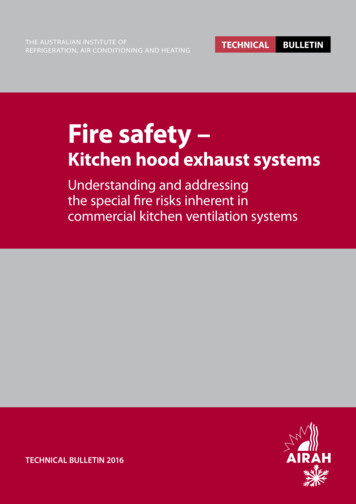
Transcription
THE AUSTRALIAN INSTITUTE OFREFRIGERATION, AIR CONDITIONING AND HEATINGTECHNICALBULLETINFire safety –Kitchen hood exhaust systemsUnderstanding and addressingthe special fire risks inherent incommercial kitchen ventilation systemsTECHNICAL BULLETIN 2016
FIRE SAFETY – Kitchen hood exhaust systemsTECHNICALBULLETINFire safety –Kitchen hood exhaust systemsUnderstanding and addressing the special fire risksinherent in commercial kitchen ventilation systemsPrefaceKitchen exhaust systems continue to featureprominently in commercial building fire events.Fire safety within kitchen ventilation systems innot just a matter for the system designer or systeminstaller. The actions of the facilities manager, themaintenance contractor, and the system owner oroperator are also critical to ensuring safe outcomes.In the light of recent updates to relevantAustralian Standards, recent changes to themaintenance requirements and focus of theNational Construction Code, and the continuingfire risks within kitchens, AIRAH undertook todevelop a fire safety technical bulletin on the exhaustventilation topic, in partnership with the industry.This technical bulletin has been developed foruse by technical service providers, facilitiesmanagers, and operators of commercial kitchens.It aims to highlight the main fire safety issues,promote a common language, and improveunderstanding of the risks and resultingresponsibilities of all participants in the supplychain, from design and installation throughto operation and ongoing maintenance.Kitchen ventilation systems and their impact onfire safety can be improved within the community.Systems need to be designed and installedin accordance with the established rules.Ongoing maintenance and inspection shouldbe targeted to the actual usage of the facilityand its delivery should be verified. AIRAH hopesthat this fire safety technical bulletin will go someway to improving industry performance in this areaand reducing the incidence of serious fires withinkitchen exhaust systems.Vincent Aherne, M.AIRAHAIRAH technical managerDisclaimerThe information or advice contained in this document is intended for use only by those who have adequate technical training in the field to which thistechnical bulletin relates. The document has been compiled as an aid, only and the information or advice should be verified before it is put to use. Reasonableefforts have been taken to ensure that the information or advice is accurate, reliable and accords with current standards as at the date of publication.To the maximum extent permitted by law, the Australian Institute of Refrigeration Air Conditioning and Heating Inc., its officers, employees and agentsa) disclaim all responsibility and all liability (including without limitation, liability in negligence) for all expenses, losses, damages and costs, whether direct,indirect, consequential or special you might incur as a result of the information in this publication being inaccurate or incomplete in any way, and for anyreason; andb) exclude any warranty, condition, guarantee, description or representation in relation to this publication, whether express or implied.In all cases, the user should also establish the accuracy, currency and applicability of the information or advice in relation to any specific circumstancesand must rely on his or her professional judgement at all times. AIRAH 20161www.airah.org.au
TECHNICALBULLETINFIRE SAFETY – Kitchen hood exhaust systemsContributorsThis Technical Bulletin was prepared by AIRAH in collaboration with a range of AIRAH members, industry organisationsand individuals. The following organisations and individuals are acknowledged for their contribution to its development:n AIRAH – Vince Aherne, M.AIRAH,n Peter Mathieson, M.AIRAHn Vanessa Morris – ACT Governmentn Jessica Ngo – CFAPhil Wilkinson, F.AIRAHn FPAA – B rett Dundules; Ian Findlay;Chris Orr, Brett Staines; Matthew Wrightn Greg Buckley – Fire NSW/AFACn Kevin O’Reilly, M.AIRAHn Peter Conroy – City of Sydneyn Ivano Piubellinin Dan Dainard, M.AIRAHn Bryon Price, F.AIRAHn Brett Fairweather, M.AIRAHn David Robinson, M.AIRAHn James Fricker, F.AIRAHn Jeremy Stamkosn Simon Hill, L.AIRAHn Grant Mogfordn David Kearsley – CFAn Ross Warner, M.AIRAHn Doug Lamacn Graeme WilliamsonAbout AIRAHThe Australian Institute of Refrigeration, Air Conditioning and Heating (AIRAH) is an independent, specialist,not-for-profit technical organisation providing leadership in the HVAC&R sector through collaboration, engagementand professional development.The Institute’s mission is to lead, promote, represent and support the HVAC and related services industry,and membership. The Institute produces a variety of publications, communications and training programs aimedat championing the highest of industry standards. AIRAH encourages world’s best practice within the industry,and has forged a reputation for developing the competency and skills of industry practitioners at all levels.2www.airah.org.au
FIRE SAFETY – Kitchen hood exhaust systemsTECHNICALBULLETINContents1. Kitchen exhaust– is there a safety problem?42. Kitchen exhaust– what are the fire hazards?43. Identifying the fire risks64. Addressing the fire risks75. Seven deadly sins96. Ongoing inspectionand maintenance137. Beyond the minimumstandards – Towardsbest practice158. Going the extra mile169. What can I do?1710. Further information183www.airah.org.au
TECHNICALBULLETINFIRE SAFETY – Kitchen hood exhaust systems1. Kitchen exhaust– is there asafety problem?There continues to be fire incidents involving themechanical exhaust ventilation systems of commercialkitchens. Given the presence of heat and high fuel loads,fires in kitchens are not uncommon. However, when theincident extends into the mechanical exhaust system,safety risks and building impacts can rapidly escalate,sometimes resulting in devastating and widespreaddamage. These high-intensity fires move and spreadrapidly, are difficult to locate and extinguish, and aresusceptible to remote re-ignition and break-out.This technical bulletin is provided to help raise awarenessamong property owners and restaurant proprietorsabout the fire risks and dangers associated with kitchenexhaust ventilation systems. It discusses the inherent firerisks, outlines regulatory and compliance requirements,highlights recent changes to applicable AustralianStandards, looks at best-practice approaches, andemphasises the importance of ongoing effectivecleaning and maintenance.FIRE FACTSDuct fires can be intense and reach temperaturesof 1,000 C within minutes – hot enough to meltsome metals and ignite surrounding combustibles.Fire statistics from Australia, the UK and the USshow that fires in restaurants predominately occurin kitchens. The ignition of cooking materialsaccounts for almost half of all commercial kitchenfires and almost all of these (90 per cent) get intothe kitchen hood exhaust system. Many restaurantsnever re-open after suffering a fire loss. Insurancepolicies may exclude claims related to uncleanedor grease-laden exhaust ducts. Insurers are awareof these fire risks – are you?2. Kitchen exhaust– what are thefire hazards?Fires are common in restaurants and typically start inthe kitchen area. Cooking materials are the most frequent‘first item’ ignited. Experience shows that the majorityof kitchen fires will involve the kitchen exhaust hoodor ductwork.Kitchen exhaust fires can spread in a number of ways.A fire that originates within the kitchen or at the hoodfilters can spread into and up the ductwork system, fuelledby the oil and grease within the duct. A fire within theduct can ignite combustible materials outside of the duct,via radiant heat transmission, or can ignite grease that hasleaked out of duct seams, spreading the fire in the building.Because fire dampers are not allowed within kitchenexhaust ductwork, fire spread within and between ductscan compromise a building’s passive fire protection suchas fire-rated compartments.Fire dampers, which are usually installed inventilation ducts to prevent fire spread, are notpermitted within a kitchen exhaust duct system.They do not work in kitchen exhaust becausegrease on the downstream side of the damperwill ignite before, and irrespective of, damper closure.The potential for false operation of the fire damperis also greater than normal and closure, other thanin a fire situation, can have serious consequencesfor kitchen ventilation.Always read the small print!Figure 1: Heat of the fire melted the metal grease filter.4www.airah.org.au
FIRE SAFETY – Kitchen hood exhaust systemsTECHNICALBULLETINFire spreads to grease on rooftopFire spreads to other systemsFire breaks outat fan inplantroomPlantroomIntermediate level(s)Burning greaseleaks out ofduct joinsShaftKitchenFire breaks out in kitchenFire spreads into exhaust ductworkFigure 2: Fire in kitchen spreading into duct and then fire in duct spreading/breaking-out to another area.Restaurants in buildings are a fire hazard. When a restaurant is located in a larger building or complex,such as a hotel, hospital, mall, airport or multi-storey residential development, the risks increase exponentially.A fire in a kitchen exhaust system in Heathrow Airport shut down three terminals, delayed or cancelled hundredsof flights, and generated hundreds of millions of dollars in losses that far exceeded the physical damage bill.That fire spread through 200m of exhaust ductwork to a plantroom before it was extinguished.Figure 3: A fire within the duct can ignite combustible materials outside of the duct, spreading the fire in the building.5www.airah.org.au
TECHNICALBULLETINFIRE SAFETY – Kitchen hood exhaust systems3. Identifyingthe fire risksA fire within the duct system generally occurs dueto the ignition of flammable material that has built upat the grease removal device (filters). The combinationof fuel, air movement and heat can result in a strongand significant fire event.GINOK NCO I T I ONIGAOX IRYGENAll fire risk analysis fundamentally boils downto the three elements that are required for a fireto occur: fuel, oxygen, and ignition or the Fire Triangle.FUELGREASE & OILFigure 4: The Fire Triangle – fuel/heat/O2 grease/flame/air.Ignition: There are many ignition sources withincommercial kitchen environments: open-flame cookingdevices, flaming cooking techniques, sparks and sootfrom wood or charcoal burners, even the heat generatedfrom some types of cooking appliances can provideenough energy to ignite warmed grease, which thenonly needs a supply of oxygen to continue burning.Flare-ups from cooking equipment are the dominantcause of ignition.Oxygen: The primary purpose of the ventilationducts is air movement, so there is more than enoughair available within the duct system to support a large fire.Once combustion commences the duct often acts asa chimney, channelling smoke and air to ventilate the fire.If this occurs in the reverse direction, large amountsof hot toxic smoke can enter the kitchen area and building,via the hoods.Fire-related hazardsin a kitchen include: Flames, sparks and hot gases from foodpreparation can ignite residues in exhaust ductsFire prevention must disrupt one or moreof these elements. Food preparation equipmentWithout heat the fire can’t begin, without fuel thefire can’t grow and without air the fire can’t spread. Failure to switch-off equipment, especiallyIn a commercial kitchen hood exhaust ventilation systemall three of these elements are highly prevalent – Overheated oils that can lead to spontaneousFuel: The grease derived from cooking processes entersthe system with the ventilation air. High air velocities helpto entrain and entrap cooking contaminants. Grease filterswill capture a percentage of this, depending on theirperformance efficiency, installation quality, and cleanlinessmanagement. No filter captures 100 per cent of the grease,and any grease that passes through or around the filterswill build-up on the internal hood, duct, and fan surfaces.Accumulated grease can leak out through duct seamsand joins, or can pool in some parts of the ductwork toprovide reservoirs of warm, highly flammable fluids andvapours that are ripe for ignition. Solid fuel cooking cancreate volatile gases created by incomplete combustionof the wood. These gases condense in the exhaust ductand mix with water vapour to form a tar-like creosotesubstance that sticks to the duct. Food preparation equipment based on solid fuelsleft without supervision during operationat the end of activitycombustion Gas blowtorches used for browning some foods Poorly operating thermostats or lackof thermostat or fault-detecting equipment Faulty or overheating electrical equipment Metal exhaust flues that conduct heatand ignite nearby material or debris Ovens without igniters/pilot lights(lit with burning pieces of paper).6www.airah.org.au
FIRE SAFETY – Kitchen hood exhaust systemsTECHNICALBULLETIN4. Addressingthe fire risksMeeting thelatest standardsCompliance with the relevant standards is very important.The National Construction Code (NCC V1 2016) requiresthat commercial kitchens are provided with kitchenexhaust hoods in compliance with AS/NZS 1668.1-2015and AS 1668.2-2012. In order for a hood to complywith AS/NZS 1668.1, the whole exhaust system must comply.These standards have been updated and it is important thatdesigners and installers are working to the correct editions.The NCC and AS 1668.2-2012 determines where kitchenexhaust hood systems are required, the minimum ventilationrates, the construction details in terms of functionality andhygiene and, importantly, the minimum distances betweenthe grease removal device and the heat source. The NCCand AS/NZS 1668.1-2015 specifies the design and installationprecautions that need to be included to mitigate the resultsof any fire that occurs in the exhaust system.AS/NZS 1668.1 requires 300mm separation or fireinsulation between ducts and combustible materials,an
Fire safety within kitchen ventilation systems in not just a matter for the system designer or system installer. The actions of the facilities manager, the maintenance contractor, and the system owner or operator are also critical to ensuring safe outcomes. In the light of recent updates to relevant Australian Standards, recent changes to the maintenance requirements and focus of the National .
